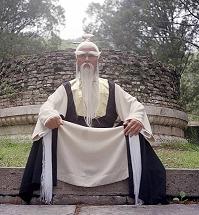|
Bak Mei literally means White
Eyebrows; also known as Pai Mei, Pei Mei, Bai Mei, Pak Mei, and Bak Mei Pai
Bak Mei played an important part in the
downfall of Shaolin temples.
Manchu took control of China in 1644. Before then, China had been ruled by
the Ming Dynasty, which had been weakened by internal corruption and
rebellion.
The Manchu dynasty became known as the Qing
Dynasty. As part of the Manchu campaign to control the Middle Kingdom, they
attacked some Buddhist Shaolin Temples. |
 |
|
The leader of the Shaolin
Temple, Hong Mei ("Red Eyebrows") died, leaving his legacy to Chi Thien
Su, also known as Jee Sin, one of the five Great Kung Fu Masters.
According to some stories another such master, Chu Long Tuyen, the monk
who would later become Bak Mei, did not accept this. He believed the
Ming had become corrupt and Chi Thien Su would still serve them; Bak Mei
would rather serve the Qing Dynasty. Then came the attack against the
Shaolin Temple at Quanzhou in Fujian province in 1647. Some sources
indicate that this temple was actually in Henan, or that the invading
forces recruited help from Tibetan warriors in the attack.
The Five Elders survived, however, and soon Chi Thien Su would found a
second Shaolin Temple at Nine Lotus Mountain, also in Fujian Province.
The Five Kung Fu Masters survived the first destruction of the Shaolin
Temple by Qing Imperial forces and sought shelter in another temple,
Fujian Temple, but the other monks were massacred. After Bak Mei refused
to provide his real name for fear of retribution (against his family and
students - if they survived), the Abbott of the temple christened the
monk "Bak Mei" - White Eyebrow. According to some stories, Bak Mei
betrayed the Ming at this point, taking information about their plot
against the Manchu to the Manchu Shunzhi Emperor, then returned with
information about the Manchu attack plan to the Shaolin. After the
temple was destroyed by the Manchu, Bak Mei and Fong Toh Tak (creator of
the Bak Fu Pai) left the temple on separate paths in order to study
Taoism.
Bak Mei trained an anti-Imperial attack force but following capture of
the force by the Imperials, was forced to teach and lead 50,000 Imperial
troops in the second destruction of the Shaolin Temple at Henan to
prevent those captured with him from being tortured and killed. There,
Bak Mei slew the "invincible" Shaolin leader, Chi Thien Su, in single
combat by breaking his neck. He claimed he did this to prevent the
massacre of the monks in the temple by the troops who followed him.
The tale of Bak Mei's death comes in many forms - it is often claimed
that he was poisoned, or slain (in a grand battle) by other martial
artists.
Bak Mei is often portrayed as a traitor, however, it is important to
note that Bak Mei's actions are not always consistent with this. Bak
Mei's actions were undertaken, even to the destruction of the temple,
with the intention of preventing harm to those who had chosen to follow
him. It is possible that if Bak Mei had not aided the Imperial forces,
his followers would have been tortured to death. |













